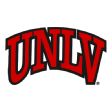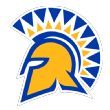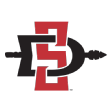On paper, the Mountain West Conference West division tends to be the inferior of the conference's two divisions. In the seven seasons since the MWC instituted two divisions and a title game, West teams have had an average SP+ rating of minus-7.9 and an average ranking of 92nd. Teams in the Mountain division: minus-1.5 and 73rd, respectively.
West teams have won four of seven conference titles in that span, however, and that includes Hawai'i's loss at Boise State last season. Fresno State and San Diego State have won two each and, per SP+, are the two favorites to reach the title game this coming fall (or spring, or whenever). But they'll both be breaking in new head coaches, as will Hawai'i and UNLV. This race might be completely up for grabs.
Jump to: UNLV | Nevada | San Jose State
Hawai'i | Fresno State | San Diego State
UNLV
 Head coach: Marcus Arroyo (first season)
Head coach: Marcus Arroyo (first season)
2019: 4-8 (2-6 Mountain West), 120th in SP+
2020 projection: 3-9 (2-6), 121st in SP+
Five best returning players: RB Charles Williams, RG Julio Garcia, QB Kenyon Oblad, FS Greg Francis, WR Randal Grimes
It remains an ongoing mystery: Why can't UNLV be good at football? From a big-picture view, the Rebels have plenty to offer. They're in an attractive city, and they have one of the best high school teams in the country, Bishop Gorman, in their backyard. It looked for a moment as if Tony Sanchez was going to crack the code. The former Gorman coach took over a two-win program in 2015 and improved to three wins in his first season, then four and five. The school finalized plans for the new Fertitta Football Complex and arranged to move out of the aging (and miles from campus) Sam Boyd Stadium and into the Raiders' swanky, new, and slightly closer Allegiant Stadium.
Unfortunately, improvement came to a halt. UNLV dropped three one-score games and slipped to 4-8 in 2018, and in 2019, the Rebels' offense was a cavalcade of injury -- by my count, three of the intended 11 starters played in all 12 games. UNLV started 2-8 before a couple of late wins. Sanchez was fired.
Now it's Marcus Arroyo's turn to test his code-breaking skills. The former San Jose State quarterback spent the past three seasons with Mario Cristobal in Oregon; he inherits an offensive two-deep loaded with potential (and, yes, injury history) and an utterly blank slate for a defense.
At QB, it could be an up-to-four-man battle among Kenyon Oblad (2019's leading passer), Armani Rogers (a great, if injury-prone, runner who has never developed as a passer), Max Gilliam (2018's passing leader) and, if eligible, Justin Rogers, a former blue-chipper and TCU transfer with his own injury history.
The line is rebuilding a bit but boasts all-conference candidate Julio Garcia, and the skill corps includes 1,200-yard rusher Charles Williams, big-play receivers Randal Grimes and Steve Jenkins, and potentially 2018's leading receiver Brandon Presley, who tore his ACL last spring.
The bad news for new defensive coordinator Peter Hansen: Of the 15 players who logged at least 200 snaps last season, only seven return. This unit has almost no known depth or proven quantities.
The good news: UNLV has ranked in the defensive SP+ top 90 just once in the past 16 years, so even with a bunch of incumbents, a new culture was a requirement. The bar is low!
A longtime Stanford assistant, Hansen will likely try to install a competition-heavy culture. You figure every job here is open. Nose tackle Kolo Uasike should win a job, and sophomores such as linebackers Malakai Salu and Jacoby Windmon, cornerback Jamel Hamm and safety Phillip Hill might be ready for advancement on the depth chart, but the names here really don't matter. If Hansen can get this D up to about 110th or so, that's an accomplishment.
UNLV moves into the new stadium and opens with home games against Cal, Louisiana Tech and Arizona State, but it would be a minor miracle if the Rebels did too much damage. This season will be primarily about figuring out which chess pieces belong where.
Nevada
 Head coach: Jay Norvell (18-20, fourth season)
Head coach: Jay Norvell (18-20, fourth season)
2019: 7-6 (4-4), 112th in SP+
2020 projection: 6-6 (4-4), 107th
Five best returning players: DE Dom Peterson, DT Sam Hammond, WR Elijah Cooks, WR Romeo Doubs, LB Lawson Hall
In my MAC East preview, I wrote about a Miami (Ohio) team that went through a youth movement and the corresponding growing pains but eked out some close victories (and got a little lucky) and managed to win the division in what was supposed to be a rebuilding season.
Consider Nevada the MWC's Miami, only a game short of a division title. Jay Norvell's third Wolf Pack squad went 7-6 and attended its second consecutive bowl despite, well, not being very good. Three QBs threw at least 40 passes (freshman Carson Strong led the way), nearly every receiver missed time, eight offensive linemen started at least one game, and the offense fell from 83rd to 113th in offensive SP+. The defense was a little luckier from an injuries standpoint but still came in just 85th. Only a 5-1 record in one-score games kept Nevada afloat.
Last season's good fortune could reverse itself, but at the same time, Strong is no longer a freshman, most of the skill corps is back, seven of those eight linemen return, and the defense ... has a new coordinator, at least.
Strong was at the helm of the offense for the best and worst moments of the season. He threw for 295 yards and three touchdowns against Purdue and completed a combined 69% of his passes during a three-game winning streak late in the season. And while Nevada lost to Ohio in the Potato Bowl, he was good: 31-for-49 for 402 yards.
During his other five games, though, he averaged just 9.5 yards per completion, threw six interceptions to one touchdown, and managed just a 105.6 passer rating. Coordinator Matt Mumme's Air Raid-ish system teaches a quarterback to take what the defense gives him, but in his bad moments, Strong was far too passive.
Junior backs Toa Taua and Devonte Lee both return, and at wide receiver, senior Elijah Cooks and Romeo Doubs combined for 1,575 yards and 12 touchdowns. Sophomore slot man Melquan Stovall could be ready for a breakthrough, too.
Norvell brought in Brian Ward to coordinate the defense. In his best moments as Syracuse's DC, Ward was able to pair great pass rushing with sturdy safety play; that's good because end and safety might be this defense's best two positions. Beefy junior Dom Peterson recorded nine sacks and 20 run stuffs last season, while end Tristan Nichols could be ready for a bigger role. At the back, the Pack have to replace their best playmaking corner (Daniel Brown) but safeties Tyson Williams, Austin Arnold and Jordan Lee are solid. The linebacker position is starting over, but that can be overcome if Nevada is good in the front and back.
Close-game performance will likely determine Nevada's fate. SP+ projects two likely wins and two likely losses in nonconference, but thanks to the home-road splits, every MWC game is projected within six points. The Wolf Pack have a better than 20% chance of going 8-4 or better and a better than 15% chance of going 4-8 or worse.
San Jose State
 Head coach: Brent Brennan (8-29, fourth season)
Head coach: Brent Brennan (8-29, fourth season)
2019: 5-7 (2-6), 99th in SP+
2020 projection: 6-6 (4-4), 106th
Five best returning players: WR Tre Walker, DE Cade Hall, CB Nehemiah Shelton, LB Kyle Harmon, WR Isaiah Hamilton
Every FBS school has its place in college football's history. For San Jose State, that place comes mostly on the offensive side of the ball. Bill Walsh went to grad school there (admittedly, his thesis, "Flank Formation Football," was primarily about defense), and maybe the two most well-known Spartans alums are quarterbacks Steve DeBerg and Jeff Garcia. Plus, over the past 30 years, SJSU has shown a lot more bright moments on O than D: According to SP+, the Spartans have ranked in the top 60 just once on defense and 11 times on O in that span.
The 2019 Spartans were an extremely accurate representation, then. SJSU scored over 30 points eight times and ranked 57th in offensive SP+, its best ranking in six years. The Spartans also went just 4-4 in games with 30-plus points because of a defense that ranked 116th. They lost games by scores of 41-38, 52-42, 42-40 and 38-35 and finished a win short of bowl eligibility.
Still, the Spartans were genuinely competitive for the first time since Brennan took over, and just enough of last season's offense returns to lead you to believe they'll be explosive once more.
Most of that explosiveness is in the receiving corps: Seniors Tre Walker and Bailey Gaither and sophomore Isaiah Hamilton combined for 2,691 receiving yards (15.5 per catch) and 12 scores. Tight end Derrick Deese Jr. and receiver JaQuan Blackwell are solid efficiency options, too. Leading rusher DeJon Packer is gone, but that's fine -- SJSU barely runs the ball.
Now the Spartans just need a quarterback. Josh Love would have crossed 4,000 yards had SJSU made a bowl (he finished at 3,923), and while sophomore Nick Nash looked awesome in a part-time audition last season (12-for-17 passing, plus 40 rushes for 255 yards), Brennan brought in Texas A&M-via-Arkansas transfer Nick Starkel for competition.
On defense, Brennan's not giving up on Derrick Odum just yet. The fourth-year defensive coordinator has yet to produce a defensive SP+ ranking better than 104th, but he was dealt an awfully tough hand. To the extent that experience and culture have been issues, the former is at least less of an issue. Senior safeties Jay Lenard and Tre Webb are anchors, and each level of the defense has at least one junior playmaker: end Cade Hall, linebacker Kyle Harmon, and corner Nehemiah Shelton. Mind you, every nose tackle needs to be replaced (Brennan signed a pair of juco transfers there), and it's hard to justifiably claim that depth is where it needs to be. But if nothing else, there's a low bar to clear here.
With an offense projected 66th and a defense projected 114th, SP+ gives SJSU an almost exactly 50-50 chance to bowl -- 50.7-49.3, actually. The Spartans have three likely wins, three likely losses, and a series of tossups, including four of the final five games. If Nash or Starkel is capable, the defense simply figures out a way to make one more stop per game, that might be enough.
Hawai'i
 Head coach: Todd Graham (first season)
Head coach: Todd Graham (first season)
2019: 10-5 (5-3), 69th in SP+
2020 projection: 7-6 (4-4), 96th
Five best returning players: WR Jared Smart, LB Penei Pavihi, RB Miles Reed, CB Cortez Davis, DE Jonah Laulu
My first reaction when I saw Hawai'i was hiring Todd Graham as its next coach was, "I guess that makes sense." The 55-year-old Graham has won 95 games in 12 seasons as a head coach and won 10-plus games five times in an eight-year span at Tulsa, Pitt and Arizona State. (He had a bit of a job-hopping problem there for a bit.) Even after a couple of years off following his firing at ASU, he might still have something to offer.
My second reaction: "Ooh, I wonder who he hires." Graham doesn't hire assistants as much as he anoints them as future head coaches. Current FBS head coaches Gus Malzahn (Auburn), Mike Norvell (Florida State), Billy Napier (Louisiana), Jay Norvell (Nevada), Jake Spavital (Texas State), Chip Lindsey (Troy) and Ryan Silverfield (Memphis) all worked for Graham at least briefly, as did former head coaches such as Chad Morris (Arkansas), Major Applewhite (Houston), David Beaty (Kansas) and Bill Blankenship (Tulsa). Graham's results faded over his last few seasons at Arizona State, and we'll see if he can get rolling again in that regard, but you could make the case that, among active head coaches, his coaching tree is more impressive than anyone's beside probably Nick Saban's.
So whom did he hire? Among them: offensive coordinator G.J. Kinne (his quarterback at Tulsa and a former analyst for both Morris and the Philadelphia Eagles), co-coordinator Tony Hull (former Kansas RBs coach for both Beaty and Les Miles), receivers coach Brennan Marion (former William & Mary OC and progenitor of the "go-go offense"), defensive coordinator Victor Santa Cruz (14-year Azusa Pacific head coach and Hawai'i alum) and co-coordinator Jacob Yoro (one of the more exciting holdovers from Nick Rolovich's UH staff).
Graham's first Hawai'i staff is a mix of veterans and exciting up-and-comers. His first roster will be similar. The Rainbow Warriors return most of the offensive line, linebacking corps and safety corps from their 2019 West division title team, but QB Cole McDonald, three of last season's top four receivers and four of the top five tacklers on the defensive line are gone. There are proven entities everywhere you look -- 1,000-yard receiver Jared Smart, all-conference left tackle Ilm Manning, star corner Cortez Davis, 900-yard rusher Miles Reed, safeties Khoury Bethley and Eugene Ford -- but if the Rainbow Warriors are to make a run at a second West title, some seemingly high-upside sophomores will have to come through: quarterback Chevan Cordeiro, defensive end Jonah Laulu, DB Kai Kaneshiro, receivers Lincoln Victor and Nick Mardner, linebacker Darius Muasau, Oregon State linebacker transfer Isaiah Tufaga, etc.
The schedule is pretty rugged, featuring trips to Arizona, Oregon, Air Force and San Diego State and visits from UCLA and Boise State. There are some wins baked in, but the progress of those youngsters -- particularly Cordeiro, who looked pretty good when subbed in for McDonald last season -- will likely determine whether Graham's fifth head-coaching stint starts as well as most of his others did.
Fresno State
 Head coach: Kalen DeBoer (first season)
Head coach: Kalen DeBoer (first season)
2019: 4-8 (2-6), 80th in SP+
2020 projection: 6-6 (4-4), 92nd
Five best returning players: RB Ronnie Rivers, DT Kevin Atkins, LB Justin Rice, RG Quireo Woodley, LB Arron Mosby
Has there been a more underrated coach than Kalen DeBoer over the past decade?
* He ran Eastern Michigan's offense from 2014 through 2016. The Eagles averaged an offensive SP+ ranking of 108.3 in the eight years before his arrival, and he had them up to 72nd by Year 3.
* In 2017, he joined Fresno State as Jeff Tedford's offensive coordinator. In his first season, the Bulldogs improved from 122nd to 81st. In his second, they surged to 16th.
* In 2019, he took over as Indiana's OC. The Hoosiers had averaged a 70.7 ranking over the previous three seasons. Despite QB injuries, they surged to 22nd.
This was all after a dominant run as an NAIA head coach -- at Sioux Falls, he won three national titles before his 36th birthday. Now he gets another head-coaching opportunity.
After maybe the best season in program history -- Fresno State went 12-2 in 2018 and finished 18th in the AP poll and 16th in SP+ -- Tedford had to replace not only DeBoer last fall, but also loads of his two-deep. To make things worse, Fresno had poor fortune in close games (1-5 in one-score finishes) and dealt with spectacular injury issues on the offensive line (11 players started at least one game, and none started more than 10) and both the defensive line and secondary. The offense backtracked a hair (from 37th to 47th, per SP+), the defense collapsed from 12th to 98th, and the Bulldogs went 4-8. Tedford resigned for health reasons, and Fresno wooed DeBoer.
A bounce-back is likely. Running back Ronnie Rivers (1,247 combined rushing and receiving yards) will probably get more help from both a line that returns seven of those 11 part-time starters and a receiving corps that includes Zane Pope, Keric Wheatfall and three sophomores who were targeted at least 16 times. Quarterback is a mystery, though. Sophomore Ben Wooldridge took a handful of snaps last season, and Washington transfer Jake Haener is eligible, but DeBoer brought in two juco transfers just in case.
A collapse in run defense was the primary catalyst for the Bulldogs' defensive issues. They got a combined six games and 257 snaps out of projected starters Kwami Jones and Jasad Haynes, and two other DEs missed time. Jones and senior Kevin Atkins are back, and sophomore tackle Alex Dumais showed havoc potential; the return of three linebackers with at least 5.5 tackles for loss last season (Justin Rice, Arron Mosby and Levelle Bailey) will help, too. The pass defense was at least decent despite massive youth and injury issues, and now six of the top eight tacklers (not including Coleman) are back. None of them are seniors.
Because of all those injuries (which SP+ doesn't account for), Fresno might be well positioned to overachieve its No. 92 projection. That could make a huge difference against a schedule that features eight games projected within a touchdown. If DeBoer performs as well in this job as he has in basically all his others, the Bulldogs could again contend in the West.
San Diego State
 Head coach: Brady Hoke (first season this time; 13-12 in a previous two-season stint)
Head coach: Brady Hoke (first season this time; 13-12 in a previous two-season stint)
2019: 10-3 (5-3), 56th in SP+
2020 projection: 7-5 (5-3), 74th
Five best returning players: CB Darren Hall, DE Keshawn Banks, S Tariq Thompson, RG William Dunkle, DT Cameron Thomas
Brady Hoke came to San Diego State in 2009 and proved the potential we've always assumed a Group of 5 program in Southern California should have. SDSU had enjoyed one winning season in 13 years before his arrival but improved from 2-10 to 4-8 in his first season, then 9-4 in his second. He established a physical style that successor Rocky Long (his defensive coordinator there) would take to great heights when Hoke left to take the Michigan job.
With Long electing to resign and go back to being a coordinator (at New Mexico), circling back to Hoke has logic. But that logic requires you to ignore everything on Hoke's résumé since he left. After an 11-win debut at Michigan, he went just 20-18 in three years and got fired. He spent a year as Oregon's defensive coordinator in 2016, and the Ducks ranked 106th in defensive SP+. He spent 2017 as Tennessee's defensive line coach, and Butch Jones got fired. (Not Hoke's fault, but we're rolling here.) He was fired as Carolina Panthers DL coach with a few weeks to go in his first season.
Hoke came back to SDSU in 2019, again as DL coach, and the Aztecs rose to 15th in defensive SP+, their best ranking since the 1970s. So maybe there's something about San Diego that brings out the best in him. But he bears a burden of proof, and with the Aztecs having averaged 9.8 wins per season since 2015, the bar's a lot higher than it was his first time around.
Instead of keeping things in the family and trying to build off of Long's defensive success, Hoke hit the reset button and brought in former Eastern Kentucky DC Kurt Mattix, who, in four years there, averaged just a 60.3 defensive SP+ ranking in FCS. SDSU returns some dynamite talent in linemen Cameron Thomas and Keshawn Banks, cornerback Darren Hall and a foursome of senior safeties; we'll see how they take to a different scheme.
The bar's a lot lower for new offensive coordinator Jeff Hecklinski, former playcaller at Indiana State. He will likely maintain the run-heavy tendencies SDSU got used to under Long, but the Aztecs were pretty bad at running last season (120th in rushing SP+, 122nd in overall offensive SP+), and that was with RB Juwan Washington and two all-conference linemen. We'll see if Hecklinski has the pieces to run well. And whom will he decide on at quarterback, where Ryan Agnew is gone and any number of potential replacements -- sophomore Carson Baker? Georgia Tech transfer Lucas Johnson? Athletic career backup Jordon Brookshire? -- could end up with the job?
SP+ doesn't take coaching changes into account, but solely on paper SDSU has a good chance at scoring its first West title since 2016. But the road schedule is pocked with land mines, and the Aztecs are favored by more than one score in only three games. If Hoke's changes don't bear fruit, if he doesn't regain the magic he left a decade ago, there's potential for a pretty steep fall here.
